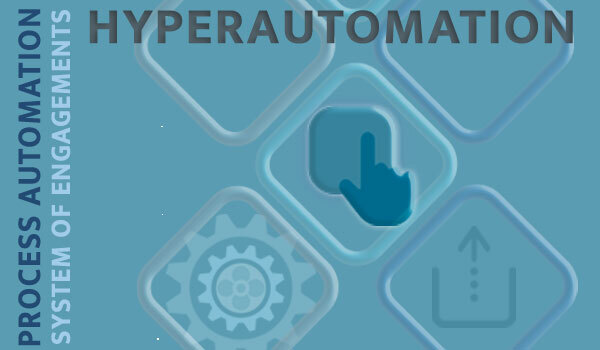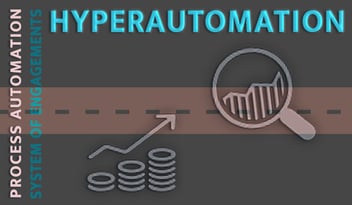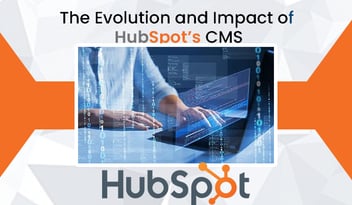Hyperautomation refers to a set of processes and tools used to scale the development and deployment of automated systems throughout enterprise businesses. Hyperautomation is separate and somewhat distinct from regular business process automation (BPA) while some of its challenges to implementation and optimization are the same.
The act of streamlining specific tasks with automation, with either single software or stand-alone PaaS, vs. automated processes in concert saving money and time, while composing the basis for future business agility. A reduction in manual errors, an elimination of mundane tasks, along with better workflow (and communication), with fewer steps, tends to do that.
.jpg?width=595&name=image-1_final%20(1).jpg)
Hyperautomation is the next step in business automation, leveraging advancements in AI and machine learning to execute a more integrated and complete process automation across platforms, teams, and departments.
Some commonly automated processes include employee onboarding, marketing, and inventory management. Hyperautomation is also occurring at the IT level, within which laborious processes such as DevOps runbook are streamlined with precise alerts, messaging and notifications, with complete stack monitoring to achieve more integrated system management.
Digital Transformation through Hyperautomation
Like automation, Hyperautomation relies on robotic process automation to employ digital workforces that mimic certain human activities like data analysis and systems navigation. If a task is performed by a human, software applications can be programmed to perform any repeatable pattern or workflow.
While businesses have been reaping the benefits of BPA using RPA’s executed by solo, task-specific software for a number of years, Hyperautomation represents the first opportunity overcoming the limitations inherent to this approach. Not the least of which is scalability.
.jpg?width=842&name=image-5_final%20(1).jpg)
Doing so requires understanding what tools are at your disposal and using them to target opportunities for a more integrated and goal-oriented automation implementation. Technical problems can arise when baseline programming dosen’t transfer to new processes or creates new barriers to workflows. Failing to plan for these can risk raising the hurdles to automation adoption, not the least of which is workforce blowback. Lack of process standardization can also create uneven results and hamper ROI.
A quick note: Consider being proactive and overcome resistance from your workforce Get started by emphasizing that their adoption revolves around enhancing mission-critical applications and can help move past dated and arduous processes that cause more collaborative and creative projects to fizzle. It doesn’t make sense to simply automate the previous process with simple human mimicry, the automation must generate new efficiencies and play to the unique strengths of your RPAs.
Analyzing where a business stands in its automation journey, which can be a reflection of its overall digital transformation journey, can, in part, be performed by understanding to what extent its using the following checklist of tools:
- BPA with RPA’s - In instances where members of your organization are completing high-volume repetitive tasks and these create substantial organizational bottlenecks, are you are using RPA’s for greater speed, accuracy and transparency?
- Building RPA’s and other BPA tools with low or no-code development, automation workload for end-to-end task completion, and iPaaS for systems integrations?
- Creating adaptable and reusable BPA’s that incorporate decision-making or display interfaces for access to actionable data, or business rules management software for operational precision?
- Deploying any natural language processing, (NLP) optical character recognition and machine vision tools, or, more commonly, virtual agents and chatbots that rely on extended Machine Learning or AI capabilities?
It all starts with robot automation, or ‘bots’ as is often said colloquially. A term popularized by users of certain bird-based social platforms, ‘bots’ are used similarly within applications to identify and execute in concert to deliver faster than repetitive human input. Their popularity on the bird platform, and others, is owed to how intuitive their installation and deployment can be. They are Programmed to observe human digital behavior and replicate its core actions in the form of rules-based processes. Whether those humans or applications that are spanning your enterprise, are localized to specific departments and individual processes.
Hyperautomation’s unique promise
These robots work by being programmed to observe human digital behavior and replicate its core actions in the form of rules-based processes, with Hyperautomation advancements in machine learning and AI are bridging new process gaps by orchestrating families of artificial intelligence capabilities to intelligent business operations.
The key examples:
- Natural language processing (NLP), which lets bots interpret human speech
- Optical character recognition (OCR), which lets bots convert images to readable text
- Machine learning (ML), which lets bots identify patterns in data
These technologies work in concert with one another to dramatically expand the automation possibilities that weren’t previously feasible. General use cases include data discovery, data preparation, data replication, and data warehouse maintenance. It allows enterprises to monitor, measure, and prove the business outcomes facilitated by automation to promote continuous growth by enhancing both customer-facing processes and internal ones. This saves costs, boosts productivity, and will make efficiency gains throughout both the automation and hyperautomized processes, while also capitalizing on the data collected and generated by them.
A key question is whether your process will require agnostic or prebuilt bots for specific processes. While a growing number of IT processes deploy agnostic RPA technologies, at times for aforementioned data-based use cases, business applications often require out-of-the-box solutions. In fact, a cottage industry has sprung up around building turnkey process-agnostic and process-dependent workflow robots that have targeted the early and current candidates for automation. This choice directly affects eventual hyperautomation efforts, or as Gartner 2020, put it, ‘automating the automation.
Automate to Hyperautomate (or Hyperautomate to Automate)
First, gain a better understanding of how hyperautomation works, get an overview of the types of questions asked when building and optimizing RPAs:
How to increase robotbotworkrates? Through volume and optimization of bot activity. Large numbers of RPA robots can work together to carry out a business process. Easily change which business process each of your robots is executing, letting them work on different processes at different times.
How to expand usage scope? This aspect of scalability means support for broadening how and where RPA is used in an organization. You might start by automating a process in one part of your business and then expand by creating RPA solutions for processes in other departments.
How to improve ease of access? Grant access for a higher number of people and process management points. Automated business processes often need to access new technologies, such as applications or integration platforms. This access can be viewed through a lens of scalability because your RPA solutions will have additional use cases.
.jpg?width=842&name=IMAGE-4_final%20(1).jpg)
The problem, If you're deploying any number of the aforementioned automated and intelligent modalities in your enterprise, has been their transferability and scalability. However, without an enterprise-wide strategy, performing true hyperautomation, as opposed to what’s simply a long list of automation silos, acting independently and absent any actionable input or output metrics. While many automation tools have developed into out-of-box and one-size-fits-all solutions, enterprise hyperautomation requires more customization that not only industry, company and process specific but connects automations at logical points.
To be clear, these issues above are just as much at the heart of fully optimized basic automation scenario but understanding those challenges is key to understanding the conversation emerging around Hyperautomation. In essence, Hyperautomation is about creating a framework for the strategic deployment of various automation technologies, including RPA, separately or in tandem and augmented by AI and machine learning to make it more scalable.
You may be thinking that your company cannot benefit from hyperautomation because you’ve been slow to adopt or optimize your current automation or perhaps fear of additional or unexpected costs.
In fact, being ‘behind’ could be an advantage and total game-changer if it forms part of a broader digital transformation strategy, If your organization is constrained by repetitive manual processes, siloed business units, and legacy systems, implementing RPA could enable you to gain significant efficiency and make sense to do so concurrently with, say application integrations or hybrid-cloud adoption.
In this case, your team will already be modifying its administration and maintenance points and processes. As luck would have it, we support significant digital transformation for a number of cloud-based, legacy, and mission-critical systems.
Steps to scaling
While several templates for automation exist, the following is the simplest to understand the broad organizational direction needed to Hyperautomate.
1. Process Mining (Yes, Again): Process mining is essential to any automation effort and businesses conducting previous procedure analysis will want to consider opening the books and finding areas of improvement. You’re likely to at least have key new team members whose input you’ll want to consider. There will likely be opportunities to do so at any of the discovery, conformance, and enhancement stages. If your processes have changed quickly, like most enterprise institutions - or your applications - you may want to toss out previous programming frameworks altogether.AI technologies can assist your organization here, as well, allowing you to record workflows and produce process maps. No and low-code drag and drop templates allow you to choose from pre-automated activities and build processes that are scalable and transferable. Assists from 3rd party or internal Code C# (link to non-business source) programmers will aid in customization and portability. Depending on where you are in your automation journey, applying these steps can be simple or challenging. Have us do an audit of previous process mines and the previous automation efforts to find out.
The needs for IT automation can be significant and allow for immediate time and cost savings while making more adequate use of deep skillsets. A CI/CD pipeline enables DevOps teams to automate the software delivery process, including prompting code builds, automated tests, and deploying to a staging or production environment hosted in either the cloud, legacy or hybrid systems. .
3. Common coding workflows, both project or waterfall approaches to automation often experience difficulties because everything is decided in advance, limiting the ability to project budgets and timetables. This is particularly true for legacy systems that don’t provision resources well or create isolated workspaces. This rigidity means that if issues arise months into a project, there is no maneuverability, so entire automation projects may have to be redesigned from scratch.
However, adopting CI/CD can be very challenging because a range of stakeholders will demand input, with their goals often conflicting with one another. Start with easy applications with forming a dedicated CI/CD team at top-of-mind with representatives from different areas of the organization including if-this-then-that tools, from-scratch scripts, powerful Webhooks, APIs, and a range of 3rd party integrations
Applying this agile approach makes risk and rework are manageable. By adopting them before you start your automation project, your team is more likely to find the most optimal and long-lasting changes.
4. Process standardization: One of the most problematic aspects of implementing automation. The more complex the process the more difficult and costly it can be to automate. Complex use cases increase both operating costs and business disruption because, as processes become more complex, unpredictable, and fragmented, the cost of automation build.To see a meaningful, long-term return on investment, it is these types of complex business processes that need to be automated. This means you cannot rely on one automation technology to all your complex processes. For truly difference-making automation that delivers significant returns across the organization, you need to combine several automation technologies.
.jpg?width=842&name=IMAGE-2_final%20(1).jpg)
Here’s a general rule to follow about new processes: Workforce adherence to a new automated workflow should not be done by coercion and encourage improvisation at administrative points that make sense for your team. While there are often limitations in this sense based on what the technology allows, don’t assume its your most senior team members that have to have the broadest access.
And another: Depending on the speed of adoption, existing experience with automation, If it requires additional or third-party administration beyond the first few months, consider an outside audit. The new processes administrators It should not require the users to master any new programming languages or skillsets to operate the automated workflow.
5. Testing + Going Live. As you’ve probably been told, maximizing ROI involves adopting a long-term outlook, sufficient training, and testing for truly end-to-end automation. Testing will come at several steps of the process, perhaps while modifying team processes and generating multiple process alternatives before engaging the automation mapping and build.
It is certain to come post-build, where you’ll seek to combine both hard metrics and anecdotal data to uncover resistance and technical hurdles to adoption. For the latter, try a formal survey or questionnaire, rather than informal feedback. Even if your team is small, they will respect the time and opportunity to voice their whole opinion, while getting more acclimated to the idea of automation.
After going live, keep in mind that the ability to autonomously execute process steps or even complete processes is what defines automation. While the engine must be taught and as such requires a human-in-the-loop, with increasing hyperautomation, businesses can decide to run processes autonomously. This holds true for both IT Automation and business processes including desktop, web or virtual desktop interfaces, text-based data, email, IT, where human actions can all be fully or partially automated.
The term digital labor is becoming a buzzword, and it applies here to deploying automated processes and transitioning to a new model. The opportunity to delve into what serious workflow disruption with automation would look like because of the COVID-19 pandemic and WFH.
These circumstances offered companies insight into how to determine what are an individual’s contributions - and weaknesses. As such, teams have sought to streamline processes both personally and as a group, in response to a new set of daily tasks that require access to new, off-site systems with unique workflows. Many companies have used these unique circumstances to accelerate their digital transformation, committing more resources to cloud to enable a smooth provision of services and more elasticity in the day-to-day resources required, sometimes automating those based on the emerging predictability of IT resources amid the ‘new normal.
.jpg?width=842&name=IMAGE-3_final%20(3).jpg)
The latest advancements working in concert
Hyperautomation will continue to be enhanced by advanced machine learning will aim to build on its ability to learn human behavior while pivoting to the scaling and optimization of uniquely robotic approaches to processes. This will eventually make process automation more proactively agnostic, while also being more diagnostic in determining what input it needs from its human counterparts. The core benefit will be a system of self-reinforcement and remediation that interacts with a human workforce in a more harmonious way. With the goal being true end-to-end automation, by blending self-learning (i.e. non-deterministic automation) with a transfer of knowledge from one domain to another. In the long term, this will force a reexamination of workforces and their role in an enterprise business focusing on end-to-end process completion rather than the execution of repetitive or even domain-specific tasks.
It’s high time with industries taking a quantum leap to the future by implementing hyperautomation. However, working with the right innovation partner can take a lot of overheads off your plate and enable you to build quickly, go to market faster and stay ahead of the competition. If that’s the kind of help you are looking for, get in touch.





Leave a Comment